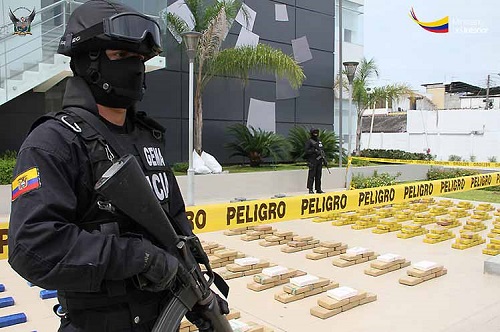By
Ricardo Swire
On Tuesday November 14, 2017 the Mexican Attorney-General’s (AG) Office or Procuraduria General de la Republica (PGR) issued a report about Mexican drug Cartels’ occupation of Ecuador. The claim was rebutted by a Ministry of Interior, National Police of Ecuador Counter-Narcotics official. Mexico’s AG stated the Gulf, Sinaloa, Zetas and Familia Michoacana Cartels are mainly accommodated in Colombia, China, Ecuador, Peru and the United States. The Ecuadorian law enforcer confirmed a transnational drug trafficking syndicate presence in his country, but refuted the idea of local Mexican bases that export drugs. He stated Mexican drug cartels use Ecuador exclusively to launder cash.
Caribbean internal security intelligence officials’ analysis of trafficking trends outlined the legend of an Ecuadorian drugs trade initially controlled by Colombian Cartels. Over the years Colombian Kingpins held the monopoly on Ecuadorian trafficking routes. Cocaine from Colombia warehoused in Ecuador before travelling to Central America and the US. Mexican traffickers dispatching wholesale product northward, purchased from Colombians in Ecuador, the departments of Narino and Putumayo in southwest Colombia sharing a border with Ecuador.
Cocaine is smuggled to towns in Macara, Tulcan, San Lorenzo and Nueva Loja. In one counter-offensive Ecuador’s government assigned seven thousand soldiers and three thousand police officers on the border to arrest the Colombian drug flow. Nevertheless movement continued to Ecuador’s Pacific port cities. Colombia’s Rastrojos Cartel members coexisted with Mexico’s Sinaloa Cartel representatives in Ecuador, enjoying a mutually beneficial and cordial working relationship. But in 2011 the Sinaloa Cartel attempted to hijack full control of Ecuador’s drug smuggling outlets.
Corresponding records reflected nine Sinaloa Cartel traffickers intercepted by National Police of Ecuador officers. In twelve months counter-narcotics enforcers seized two drug planes. One aircraft transported one point five tons of cocaine, the other carried US$4 million cash. A suspicious light-airplane crash in Ecuador’s Manabi district is also highlighted. The wrecked Mexican registered plane did not file a flight plan with air traffic controllers and flew at tree top height to avoid radar detection. Two Mexican pilots died when the mystery plane carrying US$1.3 million undeclared currency perished.
Caribbean internal security intelligence records tabulated between June and September 2012 one point nine tons of cocaine were confiscated in the Manabi district. In eighty percent of the seizures Ecuadorian police paid local traffickers from US$20,000 to US$40,000 for information on each other’s shipments. Three Mexican traffickers arrested aboard a go-fast boat in coastal waters off San Vicente, Manabi demonstrated cross border tenacity.
The Ecuadorian National Police of Ecuador Counter-Narcotics official’s rebuttal of the Mexican PGR’s November warning is further overshadowed by the impounded drug-boat’s stored GPS data. Recovered coordinates plotted the vessel’s clandestine course from Mexico to a refueling point in Central America, onward to Ecuador. The Galapagos Islands is a popular maritime resupply location. In 2014 a Mexican registered plane was intercepted in Ecuador’s Los Rios province transporting one ton of Colombian cocaine destined for Mexico. In Hacienda la Clementina fifty-three tons of cocaine were seized prior to the Mexican drug plane’s interception.
Ricardo Swire
Ricardo Swire is the Principal Consultant at R-L-H Security Consultants & Business Support Services and writes on a number of important issues.



No Comments Yet!
You can be first to comment this post!